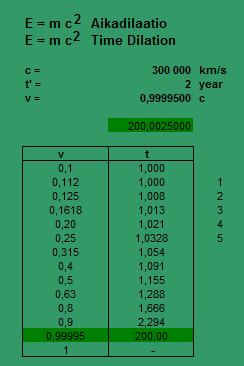Twin Paradox
 In 1911, Paul Langevin gave an example by describing the story of a traveler making a trip at a Lorentz factor of γ = 100 (99.995% the speed of light). The traveler remains in a projectile for one year of his time, and then reverses direction. Upon return, the traveler will find that he has aged two years, while 200 years have passed on the Earth. In 1911, Paul Langevin gave an example by describing the story of a traveler making a trip at a Lorentz factor of γ = 100 (99.995% the speed of light). The traveler remains in a projectile for one year of his time, and then reverses direction. Upon return, the traveler will find that he has aged two years, while 200 years have passed on the Earth.
Max von Laue (1911, 1913) elaborated on Langevin's explanation, using Minkowski's spacetime formalism. He wrote that the asymmetric aging is completely accounted for by the fact that the astronaut twin travels in two separate frames, while the Earth twin remains in one frame, and the time of acceleration can be made arbitrarily small compared with the time of inertial motion. Eventually, Lord Halsbury and others removed any acceleration by introducing the "three-brother" approach. The traveling twin transfers his clock reading to a third one, traveling in the opposite direction.

19.12.2014*10:11 (926 -190)
www.karikolehmainen.com
epcalculation@gmail.com |